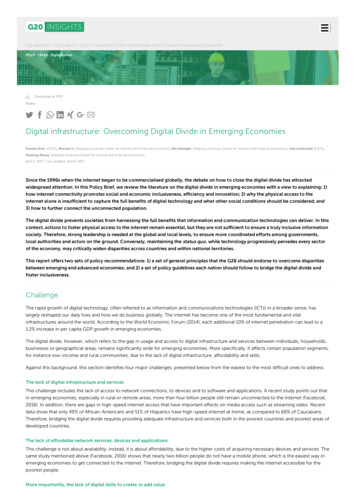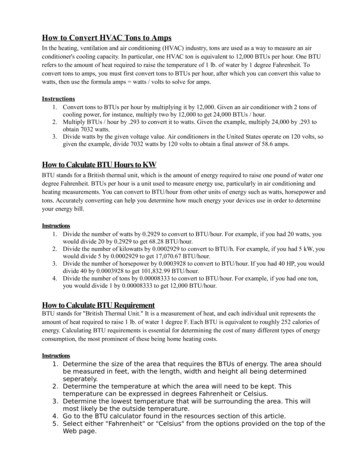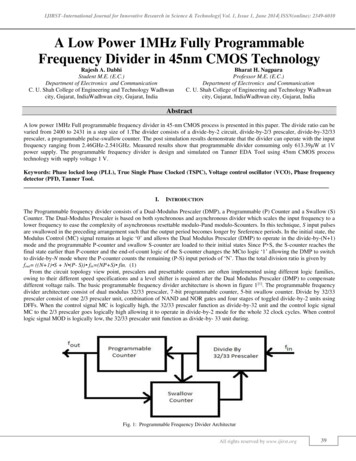
Transcription
G20 INSIGHTS POLICY BRIEFS DIGITAL INFRASTRUCTURE: OVERCOMING DIGITAL DIVIDE IN EMERGING ECONOMIESPOLICY AREA: DigitalizationDownload as PDFShare:Digital infrastructure: Overcoming Digital Divide in Emerging EconomiesRomain Bosc (CEPS), Wenwei Li (Zhejiang University Center for Internet and Financial Innovation), Ben Shenglin (Zhejiang University Center for Internet and Financial Innovation), Felice Simonelli (CEPS),Ruidong Zhang (Zhejiang University Center for Internet and Financial Innovation)April 3, 2017 Last updated: April 6, 2017Since the 1990s when the internet began to be commercialised globally, the debate on how to close the digital divide has attractedwidespread attention. In this Policy Brief, we review the literature on the digital divide in emerging economies with a view to explaining: 1)how internet connectivity promotes social and economic inclusiveness, efficiency and innovation; 2) why the physical access to theinternet alone is insufficient to capture the full benefits of digital technology and what other social conditions should be considered; and3) how to further connect the unconnected population.The digital divide prevents societies from harnessing the full benefits that information and communication technologies can deliver. In thiscontext, actions to foster physical access to the internet remain essential, but they are not sufficient to ensure a truly inclusive informationsociety. Therefore, strong leadership is needed at the global and local levels, to ensure more coordinated efforts among governments,local authorities and actors on the ground. Conversely, maintaining the status quo, while technology progressively pervades every sectorof the economy, may critically widen disparities across countries and within national territories.This report offers two sets of policy recommendations: 1) a set of general principles that the G20 should endorse to overcome disparitiesbetween emerging and advanced economies; and 2) a set of policy guidelines each nation should follow to bridge the digital divide andfoster inclusiveness.ChallengeThe rapid growth of digital technology, often referred to as information and communications technologies (ICTs) in a broader sense, haslargely reshaped our daily lives and how we do business globally. The internet has become one of the most fundamental and vitalinfrastructures around the world. According to the World Economic Forum (2014), each additional 10% of internet penetration can lead to a1.2% increase in per capita GDP growth in emerging economies.The digital divide, however, which refers to the gap in usage and access to digital infrastructure and services between individuals, households,businesses or geographical areas, remains significantly wide for emerging economies. More specifically, it affects certain population segments,for instance low-income and rural communities, due to the lack of digital infrastructure, affordability and skills.Against this background, this section identifies four major challenges, presented below from the easiest to the most difficult ones to address.The lack of digital infrastructure and servicesThis challenge includes the lack of access to network connections, to devices and to software and applications. A recent study points out thatin emerging economies, especially in rural or remote areas, more than four billion people still remain unconnected to the internet (Facebook,2016). In addition, there are gaps in high-speed internet access that have important effects on media access such as streaming video. Recentdata show that only 49% of African-Americans and 51% of Hispanics have high-speed internet at home, as compared to 66% of Caucasians.Therefore, bridging the digital divide requires providing adequate infrastructure and services both in the poorest countries and poorest areas ofdeveloped countries.The lack of affordable network services, devices and applicationsThis challenge is not about availability; instead, it is about affordability, due to the higher costs of acquiring necessary devices and services. Thesame study mentioned above (Facebook, 2016) shows that nearly two billion people do not have a mobile phone, which is the easiest way inemerging economies to get connected to the internet. Therefore, bridging the digital divide requires making the internet accessible for thepoorest people.More importantly, the lack of digital skills to create or add value
More importantly, the lack of digital skills to create or add valueThis challenge means that internet users in emerging economies cannot create added value even when they have access to the internet, ICTdevices and applications. Cullen (2001) points out that although conditions to ensure physical access to the internet are essential, they are notsufficient alone to achieve the “full benefits” of digital technology (which are discussed in the next section of this brief). The essential lesson ofthis challenge is that, without proper education and skill training, the potential of digital technology cannot be fully tapped. Therefore, digitalliteracy is key to enable citizens and companies to use the internet and foster a deeper integration of digital technologies into business andpublic services. Stronger attention should be drawn to the necessary conditions to develop the knowledge and the shared competencenecessary to achieve a more inclusive digital economy.Most importantly, the lack of coordinated efforts to foster social and economic equalityThis challenge means that digital technology is neutral. Its potential cannot be released without coordinated efforts from humanorganizations: governments, industry, civil society organizations and academics. In the absence of such coordinated efforts, we could witnessnegative impacts, such as the following scenarios:When the internet delivers scale economies for firms but the business environment inhibits competition, the outcome could be excessiveconcentration of market power and the rise of monopolies, preventing future innovation.When the internet automates many tasks but workers do not possess the skills that technology requires, the outcome will be greaterinequality, rather than greater efficiency.When the internet helps overcome information barriers that impede service delivery but governments remain unaccountable, the outcomewill be greater control, rather than greater empowerment and inclusion.The essence of this last challenge is that the internet is a powerful tool that can do positive or negative things; it all depends on the way it isharnessed. Interestingly, the negative impacts listed above are most likely to happen in emerging economies.Closing the digital divide may play a critical role in the development of the emerging economies, as it can improve the social and economicequality, favour social mobility of people and boost innovation and economic growth. Against this background, G20 policymakers and otherleaders should coordinate their efforts and adopt innovative solutions to tackle all these challenges and achieve a sustainable and inclusiveprosperity throughout the globe in the digital era.Proposal1. Possible responses from the G20Digital technologies have fundamentally reshaped our lives by expanding the base of information, reducing the costs for information sharing,transmission and acquiring, and bringing innovation that lead to the greater connectivity among people, businesses and governments (WorldBank, 2016). We divide this section into two parts: the first defines the “full benefits” to expect from digital development; the second suggestsconcrete measures to be implemented to overcome the digital divide.Part 1: What are the “full benefits” of ICT and internet connectivity?The ultimate goal of closing the digital divide is to inclusively provide every member of a society with an equal opportunity to benefit fromdigital development. The “full benefits” of the digital development include the following aspects.The ICT and internet connectivity promote efficiencyFirst, the decline in the price of digital technologies has led businesses and governments to replace traditional factors such as labour and nonICT capital with ICT capital and to automate some of their activities. Second, digital technologies strengthen the factors that are notsubstituted and make them even more productive. By optimizing the production process and increasing the productivity of existing factors,digital technologies increase economic efficiency with potential benefits for firms, workers and governments.The ICT and internet connectivity promote social and economic inclusivenessBy cutting down the costs for information sharing, transmission and acquiring and increasing transparency, the development of ICT and theinternet reduces the inefficiency caused by the lack of information or information asymmetry, and makes new transactions possible.Nowadays, mobile technologies and all forms of e-commerce such as B2B, B2C and C2C, the sharing economy, online reputationmechanisms and digital identification systems all help to overcome the information barriers. While the ICT and the internet make the marketmore efficient, one of the greatest benefits seems to be their market-creation effects: expanding trade, creating jobs and increasing access topublic services—and thus promoting social and economic inclusion. The concept of ‘market creation’ can be very well explained by thefollowing paragraph:When most industries emerge, their products and services are so costly and inaccessible that only the wealthy can buy and use them. Marketcreating innovations transform such offerings into products and services that are cheap enough and accessible enough to reach an entirelynew population of customers. The Model T Ford, the personal computer, the smartphone, and online equity trading are examples of marketcreating innovations. Because many more people can buy such products, the innovators need to hire more people to make, distribute, andservice them (Mezue et al., 2015).The ICT and internet connectivity promote a new economyThe rapid growth of ICT and the internet also leads to the booming of the “new economy”, in which transactions are executed in an extremely
efficient fashion: highly automatic without human input, and at low cost. By enabling almost frictionless communication and collaboration, theinternet can support new delivery models, encourage collective action and accelerate innovation.Table 1. The benefits of digital technologies for business, people and governments:EfficiencySocial & Economic InclusionNew EconomyBusinessCapital utilizationTradeCompetitionPeopleLabour productivityJob OpportunitiesConsumer welfareGovernmentsPublic sector capabilityParticipationVoiceSource: World Bank (2016).Part 2: Our proposalsThe digital divide commonly encompasses two main aspects: 1) the conditions to access ICTs from the supply side of digital infrastructuresand services and 2) the levels of internet use and the motivations and abilities in using ICTs and internet services. The concept keeps onevolving along with technological developments supported by industrial trends (e.g. internet of things), emerging consumption patterns, andthe uptake of new devices and applications (e.g. smartphones, tablets, smart TVs) spurring demand for an increasingly heavy load of datatraffic on communications networks.There may not be quick or easy solutions to the problem of the digital divide. Although the physical access to the internet is most essential,other factors are equally important to foster the up-take of digital technologies and ensure meaningful investment in infrastructure. In line withthe four challenges we have identified in the section above, we suggest the following actions to bridge the digital divide in emergingeconomies.Connect the unconnectedA useful framework for analysing supply-side ICT policies is to consider the value chain that stretches from the point where the internet entersa country (the first mile), passes through that country (the middle mile) to reach the end user (the last mile), and certain hidden elements inbetween (the invisible mile).The first mile can be improved by liberalizing the market for satellite dishes and eliminating monopoly status over the international gatewayand cable landing stations.Strengthening the middle mile involves liberalizing the market for building and operating backbone networks, encouraging open access tothe incumbent’s network, requiring all major infrastructure programmes (such as roads, railways, pipelines and energy distribution) toinclude provision for an optical fibre link, setting up internet exchange points and creating local caches for frequently used content.Government policies can encourage the provision of last-mile connectivity by permitting competing facilities, especially for intermodalcompetition (between cable, wireless and digital subscriber lines), and mandating the incumbent to make local access lines available tocompetitors at wholesale prices (local loop unbundling).The most critical portion of the invisible mile involves spectrum management, which requires increasing the amount of spectrum available,ensuring competitive access, encouraging sharing of essential facilities, such as radio masts, and liberalizing the market for spectrum resale.Affordability: Government subsidies or policy can be designed to make internet devices such as smartphones so cheap that everyone canown one; the internet service can become affordable by pricing the services based on service regions and income levels.China’s efforts to overcome the digital divide, in a programme called “Villages Connected”, is a good example in this respect. Some 80% ofChina’s population live in rural areas called villages. They are typically farmers who have low incomes and low educational levels. There areabout 69,000 villages. In the last decade or so, the Chinese government has made it one of the top priorities to get all villages connected. Theefforts are carried top-down by central to local government and the telecommunications industry. The result is that all villages now havesome form or another of broadband internet access such as fixed, mobile or satellite.Industry innovationsIn the PC era, visionaries advocated the concept of the 100 dollar laptop. In the mobile and social computing era, we would like to call forindustry innovations to offer 20 smartphones. Smartphones have helped bridge the divide, as they provide internet access to populationspreviously disadvantaged. Pew reports that, among smartphone owners, “young adults, minorities, those with no college experience, andthose with lower household income levels” are more likely to access the internet primarily through their phones (Zickuhr & Smith, 2012).Interestingly, while smartphone ownership and internet usage continues to climb in emerging economies, rich countries or advancedeconomies still have higher rates of technology use (Poushter, 2016).Digital investments need the support of several factors, including for instance: adequate market rules, so that firms can leverage the internet tocompete and innovate; improved social digital skills, so that people can take full advantage of digital opportunities; and accountableinstitutions, so that governments respond to citizens’ needs and demands. Digital technologies can, in turn, augment and strengthen thesecomplements—accelerating the pace of development.
Education should be dynamic and stay aheadTechnology is dynamic, and so should be education. The interplay between digital investments and reforms in other areas (such as educationand innovation systems) is at the core of policy debates on the impacts of technology on societies. Goldin & Katz (2009) framed the dynamicsin the labour market as a “race between education and technology”. The same holds true for relations between digital skills and digitaltechnology. As technology progresses, some skills become obsolete. Workers must acquire new skills that help them become moreproductive thanks to this technology. Adjustment takes time and will be painful for many, but this is how economies progress. Policy andregulations should make sure that education is equally received, especially for those underprivileged such as people living in remote areas andhaving insufficient resources to access education.Technology cannot replace human beings in making decisionsThe digital divide is more than physical access to the internet or ICT. General knowledge and digital knowledge are equally important. Heregeneral knowledge means how we make decisions using the technology and how we make use of technology to create or add social justiceand economic values to a society. Although artificial intelligence (AI) is automating an increasing number of tasks, general skills revolvingaround human care and creativity for improved decision-making and ethical judgments are crucial to ensure a broader socio-economicinclusion.Reaping the benefits from enhanced digitalization is not easy as it requires a series of structural adjustments. Otherwise, digitalization makespersistent problems worse. The key insight is that for complex occupations, business activities or public services, the internet usually can makeonly a portion of the tasks cheaper, more efficient, or more convenient through automation. Another portion still requires capabilities thathumans possess in abundance but computers do not. Many traditional tasks of an accountant or bank teller are now automated, such asmaking calculations or processing withdrawals. Others require complex reasoning or socio-emotional skills, such as designing tax strategies oradvising clients. Likewise, many public services involving the provision of information or routine permissions can be automated. But others,such as teaching or policing, need a high degree of human discretion, tacit knowledge and judgment.Coordinated effortsThe first-generation of ICT policies involving market competition, private participation and light-touch regulation have led to near-universalaccess and affordability of mobile telephone, but so far they have been less successful in spreading internet services. Much of the explanationlies in continued policy failures such as regulatory capture, troubled privatizations, inefficient spectrum management, excessive taxation of thesector and monopoly control of international gateways. At the same time, the absence of global consensus in dealing with the nextgeneration issues – such as privacy, cybersecurity, censorship and internet governance – is resulting in more circumspect and diverseapproaches to internet policy.The challenges facing internet stakeholders today are as much about how networks are used (demand) as how they are built (supply). Globalinterconnectedness introduces new vulnerabilities in areas where coordination mechanisms are weak, still evolving or based on nongovernment models. Threats to cybersecurity and censorship are undermining confidence and trust in the digital economy and increasingcosts to businesses and governments, resulting in economic losses.Coordinated efforts at global level and at national level are needed in developing policies, standards and regulations to ensure a high degree ofcompetition. Similarly, greater attention should be paid to ensure sufficient re-skill and up-skill strategies, to leverage and keep pace withtechnological change. Promoting and ensuring fair and equal access to higher educational levels to a larger share of the population is key tofostering digital literacy but also importantly, to developing other complementary competences. Finally, public institutions must beaccountable and commit to achieve long-term goals.2. Our RecommendationsOur recommendations are formulated as follows: 1) at the G20 level, general principles should be set for emerging economies, supportingtheir economic development to close the digital divide globally, thus reducing gaps between poor and rich countries; (2) at the national level,governments should elaborate general policy guidelines and take action to reduce socio-economic inequalities across national populations.These guidelines should also clearly indicate specific measures and strategies to design innovation-friendly policies that every country shouldfollow to sustain their economic growth.1. G20 levelThe following guiding principles should be defined by the G20 for emerging economies. As mentioned, the purpose is to close the digitaldivide globally and reduce gaps between poor countries and rich countries.Physical access to internet or digital infrastructure is necessary but not sufficient to reap the full benefits potentially stemming from digitaltechnologies. Other complementary actions must be taken, such as skill training, affordability, innovation policy, multi-level governance andinstitutional accountability.The focus should be shifted, both in resource allocation and policy agenda-setting, from “providing infrastructure and access” to“encouraging usage of the existing infrastructure to add or create value”. This added value includes economic, education and lifeimprovements.In the same vein, the focus should be shifted, both in resource allocation and policy agenda-setting from “hardware” to “human-ware”, i.e.from “digital technology development” to investing in human capital, for instance by “enhancing digital skills training” in the short term, and“increasing the share of the highly educated population in a country” in the longer term.
Digital responsibility should be advocated, which means that internet technology or ICT in general should be used in a way to improvehuman life, equality and inclusive prosperity; not to be used as just a commercial means for profit-making.2. Country levelWhen it comes to country-level guiding principles, the purpose is to overcome disparities across the various socio-economic segments of thepopulation and between national territories.Market creation: developing policies and providing economic incentives to promote innovations that will entail market creation, which inturn will help 1) close the gap of digital divide, 2) increase the new employment opportunities and 3) eventually improve living conditions.Industry level efforts: innovation and collaboration should be highly promoted to create technologies that support the efforts ofovercoming digital divide. For example, a 20 smartphone will be a game changer in mobile internet access.Education: develop policies to adapt the education system to changing labour markets and encourage digital skill training for everyone atan affordable price.Affordability: deregulate the telecommunications industry and develop a friendly environment for digital services to flourish, at least at theconsumer application level, to foster multiple applications and encourage the use of the internet and ICT to create and add values to thesociety.References1. 1. Cullen, R. (2001), “Addressing the digital divide”, Online information review, 25(5), 311-320. 2. EU (2014), Digital agenda for en). 3. Facebook (2016), “State of Connectivity 2015: A Report on Global Internet al.pdf). 4. G20 (2015a), G20 Leaders’Communiqué, Antalya Summit, 15-16 November 2015 (http://www.mofa.go.jp/files/000111117.pdf). 5. G20 (2015b), G20 Skills /11/G20-Skills-Strategy.pdf). 6. G20 (2016), G20 Leaders’ Communique, Hangzhou Summit, 4-5September rs’-communique,-hangzhou-summit). 7. Goldin, C.D. and L.F. Katz (2009),The race between education and technology Cambridge, MA: Harvard University Press. 8. Hilbert, M. (2011), “Digital gender divide ortechnologically empowered women in developing countries ? A typical case of lies , damned lies , and statistics”, Women’s StudiesInternational Forum, 34(6), 479–489 pdf). 9. Huawei (2016a), Digital enablement/). 10. Huawei (2016b), Global Connectivity Index 2016, White Paper(http://www.huawei.com/minisite/gci/en/). 11. McKinsey (2014), China’s digital transformation nsights/chinas-digital-transformation). 12. Mezue, Bryan C., Clayton M. Christensen and Derek van Bever (2015), "The Power ofMarket Creation: How Innovation Can Spur Development", Foreign Affairs, January/February. 13. Poushter, Jacob (2016), “SmartphoneOwnership and Internet Usage Continues to Climb in Emerging Economies’,Pews Research Center, 22 February. 14. State InformationCenter of China (2013), Digital Divide in China 2013 Report (http://www.sic.gov.cn/News/287/2782.html). 15. World Bank (2016), WorldDevelopment Report 2016: Digital Dividends (http://www.worldbank.org/en/publication/wdr2016). 16. World Economic Forum (2014),Delivering Digital Infrastructure Advancing the Internet Economy astructure/acknowledgements/). 17. World Economic Forum (2016), Digital Transformation of Industries: Digital nal-january-2016.pdf). 18. Xinhuanet (2016), Highlights of proposals for China's 13th Five-Year 11/04/c 134783513.html). 19. Zickuhr, Kathryn and Aaron Smith (2012), "Digitaldifferences", Pew Researech Center, 13 April.Download as PDFShare:AuthorsRomain BoscWenwei LiBen ShenglinFelice Simonelli
Ruidong ZhangExisting Initiatives & AnalysisImplementation Overview (1) Develop a policy framework to analyse the development of digital technology and digital divide. Digital technologies lower the cost of economic and social transactions.They promote innovation, boost efficiency and inclusion. Connectivity is vital, but not enough to realize the full development benefits. Digital investments need thesupport of other social factors, for instance adequate market rules, social digital skills and accountable institutions. Market competition, public-private partnerships andeffective regulation of Internet and mobile operators encourage private investment that can make access universal and affordable. Public investment will sometimes benecessary and justified by large social returns.Existing Agreements (2)Existing Policies and Monitoring (2)Analysis and Data (1)Suggest more existing initatives and analysis!Your suggestions will be send to the authors.Surname, Name*email adress*message**necessary fieldsMORE INFORMATION ON T20Send Suggestion
The authors are solely responsible for the content and their views do notnecessarilyrepresent the views or recommendations of their related institutions.Report this Page
LATEST POLICY BRIEFSCLIMATE POLICY AND FINANCETowards a comprehensive approach to climate policy, sustainable infrastructure, and finance[.]We propose a policy package of low-carbon growth stimulation through a steep increase in sustainable infrastructure, mobilizing sustainablefinance, and adoption of carbon pricing to simultaneously achieve the objectives of the Paris Agreement and the Sustainable DevelopmentGoals. [1], [2] [.][.]Céline Bak (Centre for International Governance Innovation (CIGI)), Amar Bhattacharya (The Brookings Institution), Ottmar Edenhofer (Mercator Research Institute on Global Commons and Climate Change(MCC)), Brigitte Knopf (Mercator Research Institute on Global Commons and Climate Change (MCC))CLIMATE POLICY AND FINANCEA decentralized, consumer-driven model for the solar eco-system[.]The transition from fossil-fuel based energy usage towards renewable energy sources needs to be accelerated. The issue is at the developingcountry level, where a lack of funds and technology – both promised by international institutions but not delivered – exacerbates theproblem. Where financing i [.]To hasten the transition, a new decentralized, consumer-based renewable energy approach must be adopted. Solar energy technology isparticularly suited for this and can see early gains for climate change. The G20 can create policies to help develop products for consumers andfacilitate global privat [.][.]Amit Bhandari (Gateway House: Indian Council on Global Relations), Akshay Mathur (Gateway House: Indian Council on Global Relations), Purvaja Modak (Gateway House: Indian Council on GlobalRelations)IN THE SPOTLIGHTT20 Mumbai: Dialogue onthe Emerging WorldEconomyGateway House co-hosted a T20meeting in Mumbai on February 14,2017 in with the Kiel Institute for theWorld Economy and the Ministry ofExternal Affairs, Government of India,with support from GIZ and SiemensIndia.APROJECTBY
POLICY BRIEFSPolicy AreasLatest PolicyBriefsTHINK TANKSABOUTAbout G20 InsightsIn the spotlightContactSupportSHARE: Kiel Institute for the World Economy LegalNoticeWe use cookies to help giving you the best experience on our website. By continuing to read our website, we assume you agree to this.Got it! Web Analytics with Piwik
1.2% increase in per capita GDP growth in emerging economies. The digital divide, however, which refers to the gap in usage and access to digital infrastructure and services between individuals, households, businesses or geographical areas, remains significantly wide for emerging economies. More specifically, it affects certain population segments,










